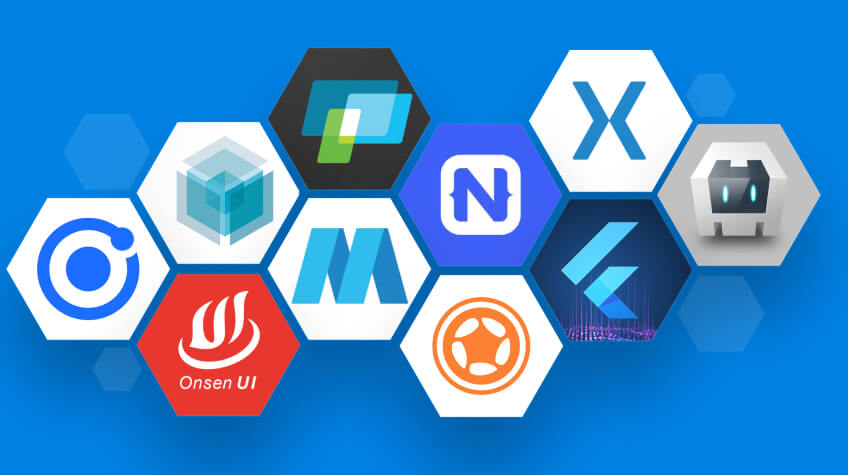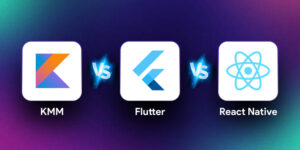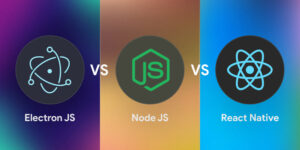
Introduction
React Native is a popular framework in mobile app development, recognized for its effectiveness and cross-platform interoperability. However, as technology evolves and expectations shift, developers seek solutions that provide distinct project advantages.
Step into a world of creativity and adaptability with non-traditional frameworks that upend the established order. There are several solutions available, ranging from Xamarin’s strong performance to Flutter’s smooth UI rendering and Ionic’s ease of use in hybrid app development. In this investigation, we show 15 dynamic React Native alternative, each with special features and functions catered to different project needs. Explore the next frontier in mobile app development with us.
What is React Native Framework?
A robust open-source framework for creating native mobile apps using React and JavaScript, React Native was created by Facebook. Its 2015 launch allowed developers to build dynamic, cross-platform applications using a single codebase, which cut down on development costs and time. With React Native, you can build interactive user interfaces with all the bells and whistles of native apps thanks to React’s component-based design.
To guarantee top speed and efficiency, it provides easy integration with both native code components and third-party libraries. Many sectors continue to use React Native as their go-to framework for mobile app development because of its strong development tools, large community, and frequent upgrades.
List of React Native alternative
1. Framework7

With Framework7, building native applications for iOS and Android from a single HTML5 page is made easier than ever before. It has been fine-tuned for three years, and its user-friendliness and affordability have made it a favorite.
Features
- Open-source framework (MIT license)
- Easy installation and setup
- Built with Sass for enhanced styling
- Compatible with all modern browsers
- Continuous updates for improved features
- Paid support plans for additional assistance
- Comprehensive documentation for easy reference
- Extensive collection of UI components for rapid development
- Integration with third-party libraries for extended functionality
Price: Free and Open Source
Choose Framework7 for seamless app development without the hassle of platform compatibility.
2. Sencha Ext JS

Sencha Ext JS is the tool you need to make apps that work on multiple platforms. Since 2009, Sencha Ext JS has been a significant player in the mobile app creation scene. It gives developers a strong base for making cross-platform apps. Because it is open source, Ext JS speeds up creation by using well-known technologies like HTML5, CSS3, and JavaScript. This means that you don’t have to learn any new languages.
Features
- Fast and intuitive coding experience
- Responsive framework for cross-platform development
- Reusable and extendable codebase
- Built-in support for touch events and gestures
- Comprehensive UI components including maps, charts, and tables
- Integration with libraries like jQuery Mobile
- Powerful grid system
- Responsive layout system
- Custom theme and stylesheet creation capabilities
Price: Starting at $1295
Elevate your app development journey with Sencha Ext JS, where innovation meets efficiency.
3. Native Scripts

Native Scripts, an alternative to React Native, revolutionizes mobile app development by empowering developers to swiftly create native Android and iOS applications using JavaScript and TypeScript. With its seamless integration of these languages, developers can leverage their full potential for enhanced productivity.
Features
- A declarative UI markup language called Vue is akin to AngularJS and React.
- The data binding layer facilitates integration with data sources like Firebase or REST APIs.
- Animation library for creating fluid transitions within the app’s UI.
- Extensive community support and ease of use.
- It is compatible with Angular 2+ and VueJS frameworks, offering flexibility in development.
- Utilizes existing web technologies such as CSS frameworks like Bootstrap, Angular Material, and Ionic.
Price: Free and Open Source
Start your journey of native app development with Native Scripts, where innovation meets accessibility.
4. Mobile Angular UI

Mobile Angular UI, an alternative to react native, presents a dynamic framework for crafting cross-platform mobile applications using the trifecta of HTML, CSS, and JavaScript. As an open-source solution, it boasts ease of use, thriving community, and compatibility with Cordova and Ionic for seamless integration of native device features.
Features
- Responsive design guarantees an excellent layout across all screen sizes.
- Touch-enabled functionality improves the user experience on smartphones and tablets.
- Modals, tabs, and navigation are all examples of interactive features that may be created using AngularJS directives.
- Includes Bootstrap components for easy integration of buttons, forms, and grids.
- Lightweight and speed-optimized, the software performs quickly and responsively.
Price range: $25k-$75k
Building complicated and feature-rich mobile applications is made easier and more efficient with Mobile Angular UI, allowing developers to simply create captivating experiences for Android and iOS devices.
5. Corona SDK

Corona SDK is a strong platform for making mobile apps. It uses the computer language Lua and has an integrated integrated development environment (IDE). It makes it easy to make high-quality games and apps that work on Android, iOS, and many other devices.
Features
- Built-in graphics engine with hardware acceleration support for seamless rendering.
- Native interface elements optimized for iOS and Android platforms.
- Automatic memory management simplifies resource allocation and optimization.
- Flexibility to create 2D and 3D games using Lua or C/C++ programming languages.
- Extensive collection of plugins available for additional customization, including multiplayer support and social media integration.
Price: Free and Open Source
With Corona SDK, developers can use the power of a full-stack solution to make games and apps that work on a wide range of devices. They can also get the benefits of an open-source framework.
6. Onsen UI

Onsen UI emerges as react native competitors, offering a free and open-source solution for crafting hybrid mobile apps effortlessly. Leveraging the power of AngularJS and Cordova, it simplifies the development process while providing over 75 readily available UI components, streamlining app creation.
Features
- Lightweight framework ensures fast performance without compromising functionality.
- Extensive collection of plugins facilitates the creation of custom components tailored to your needs.
- Cross-platform support with HTML5 and CSS3 lets apps run smoothly on a variety of platforms.
- Built-in support for graphics and movements makes the user experience better and keeps them interested.
Price: $18 to $1295
Developers can feel confident starting to make mixed apps with Onsen UI because it is easy to use, has a large community of plugins, and always follows current design standards.
7. jQuery Mobile

jQuery Mobile is a sophisticated HTML5-based UI framework that makes it simple to construct responsive webpages and mobile apps that function on a wide range of devices. jQuery, which has been around since 2006, is a stalwart in the web development service business and is utilized by a wide range of websites throughout the world.
Features
- Built-in support for responsive design ensures optimal viewing experiences across smartphones, tablets, and desktops.
- Ajax-based page loading enables instant rendering and seamless navigation.
- Customizable toolbars and icons empower developers to tailor the UI to their specific requirements.
- Custom themes can be created using CSS3, which allows for personalized branding and aesthetics.
Price: Starts at $66.72
With jQuery Mobile, creators can use the power of a time-tested framework to build vibrant and accessible web experiences while enjoying the benefits of a mobile-first approach to CSS.
8. Apache Cordova

Apache Cordova, first created by Adobe in 2011 and subsequently embraced by the Apache Software Foundation, is a flexible open-source framework that enables the development of native mobile apps utilizing well-known web technologies such as HTML, CSS, and JavaScript. Cordova streamlines the development process by providing a straightforward methodology and easy access to device APIs. This allows developers to simply create powerful applications for numerous platforms.
Features
- Interface appropriate for both novice and experienced developers.
- Ability to develop applications for many platforms concurrently, such as Android, iOS, and Windows Phone.
- Effortless use of inherent device functionalities like GPS and camera without the need for code unique to a particular platform.
Price: Free
Apache Cordova enables developers to begin their mobile app development process without limitations, using its accessibility and flexibility to build influential apps for many platforms.
9. Xamarin

Xamarin is the best cross-platform mobile development tool available. Xamarin is a strong player in cross-platform mobile app creation, using the C# computer language to create solutions that are flexible, easy to use, and compatible with different hardware. Xamarin gives both professional and individual developers the tools they need to easily make native apps for iOS, Android, and Windows.
Features
- Cross-platform compatibility ensures seamless deployment across various devices and operating systems.
- Native UI elements guarantee a familiar and intuitive user experience tailored to each platform.
- A single codebase for all devices streamlines development and maintenance efforts.
- The business logic layer can be developed once and shared across multiple platforms, reducing redundancy.
- Cost-saving benefits accrue from code sharing across projects and optimizing resources.
- Security is enhanced through automatic updates and user-friendly access control measures.
Price: Free
With Xamarin, developers can harness the power of a versatile framework without the burden of cost, enabling the creation of high-quality, reliable mobile apps for diverse platforms with ease.
10. Ionic

Since its inception in 2013, Ionic has remained a cornerstone in mobile app development. It offers a powerful open-source framework for building cross-platform applications using HTML, CSS, and JavaScript. Built on Apache Cordova, Ionic allows developers to create apps for iOS, Android, and other platforms with a single codebase.
Features
- Beautiful UI framework facilitating the creation of fast and high-quality apps.
- Mobile-first flexbox grid system for building adaptive layouts that seamlessly adjust to different screen sizes.
- Built-in support for AngularJS and SASS, enhancing development efficiency and productivity.
- Native plugins for common device APIs such as camera and geolocation, eliminating the need for additional coding.
Price: Free and Open Source
With Ionic, developers can unlock the potential of cross-platform mobile app development without constraints, leveraging its intuitive CLI and rich feature set to create compelling experiences for users across various devices.
11. Flutter

You can make high-performance mobile apps with Flutter, which is a powerful tool. It gives you a way to make mobile apps that work well and quickly. Google made Flutter, a unique open-source platform that lets users use the Dart computer language to make apps for Android and iOS. Because Flutter focuses on widgets, it’s easy for developers to make user experiences that look great. It also works on multiple platforms, which means you don’t have to manage as many different codebases.
Features
- The Hot Reload functionality enables fast iteration and issue fixes by providing immediate feedback on modifications made to the code.
- Widgets function as the essential components, allowing the development of intricate user interfaces with simplicity and the ability to be reused.
- The Dart programming language provides a comprehensive collection of libraries and capabilities, such as asynchronous programming, which greatly enhances the efficiency of the development process.
- Providing graphics at a constant rate of 60 frames per second guarantees rapid performance and uninterrupted visuals, making it perfect for gaming and animation.
Price Range: $15,000 and $200,000.
Flutter allows developers to express their originality and build high-performing mobile applications that distinguish themselves in the market. This is achieved using a complete range of capabilities and an efficient development methodology.
Also Read: Flutter vs React Native: Guide to Best Framework Choice
12. Swiftic

Swiftic is one of the world’s leading mobile app development frameworks, providing tools for building refined iOS and Android apps. Whether you’re a novice or a skilled developer, Swiftic has the features and tools you need to speed the development process.
Features
- Simplified development process with a wizard-based interface, ideal for users of all coding levels.
- A comprehensive set of components, including a navigation bar, tab bar controller, and menu bar controller, facilitate the creation of native-like apps.
- Customizable components allow for flexibility in app design and functionality.
- Improved productivity and collaboration with easier file management and better team effectiveness.
- A well-organized structure and intuitive navigation ensure a seamless development experience.
Price: Starts at $14
With Swiftic, developers can use the power of a complete framework to create high-quality mobile apps efficiently and effectively, all while enjoying the advantages of an easy-to-use interface and a competitive pricing model.
13. Appcelerator Titanium

Appcelerator Titanium is a dynamic mobile app framework that combines the best of PhoneGap and Xamarin, leveraging JavaScript for code writing. This framework supports Android and iOS development and boasts powerful features to streamline the development process and enhance app performance.
Features
- Utilizes JavaScript for code writing, offering familiarity and flexibility for developers.
- Supports Android and iOS development frameworks, ensuring cross-platform compatibility.
- Titanium Studio, equipped with its own Titanium SDK and platform-independent APIs, provides a seamless development environment.
- Alloy framework accelerates development by facilitating code reusability and faster app development.
- Schema-less data set, ArrowDB, enhances data model management and improves data transmission efficiency.
- Focus on native components ensures smoother integration and optimal app performance.
Price: Starts at $15
With Appcelerator Titanium, react native competitors, developers can create high-quality mobile apps efficiently and cost-effectively, leveraging its robust features and intuitive development tools.
14. Quasar

Quasar Framework stands out as a powerful tool for developers, leveraging the Vue.js ecosystem to enable code once, deploy everywhere functionality. With a single codebase, developers can seamlessly deploy websites (SPA, PWA, SSR), mobile apps (iOS, Android), and desktop applications (using Electron), catering to diverse platforms with ease.
Features
- State-of-the-art UI following Google Material guidelines ensures modern and visually appealing designs.
- Built-in optimizations such as HTML/CSS/JS minification, cache busting, and code-splitting enhance performance.
- Support for ES6 transpiring, tree shaking, and lazy loading optimizes resource utilization and speeds up loading times.
- Comprehensive documentation and active community support provide developers with resources and assistance.
- Quasar CLI offers additional features like hot-reloading for efficient development workflows.
- 100% free, open-source, and licensed under MIT, ensuring accessibility and flexibility for developers.
Price: Free
With Quasar, developers can leverage the power of Vue.js and a feature-rich framework to build high-performance web, mobile, and desktop applications effortlessly, all without any cost constraints.
Conclusion
In the rapidly evolving landscape of mobile app development, React Native alternative frameworks offer diverse options to cater to developers’ specific needs. From Flutter’s cross-platform prowess to Ionic’s robust UI components and Xamarin’s C# flexibility, each framework presents unique advantages.
Whether it’s leveraging Swiftic’s native-like experiences or harnessing Vue.js with Quasar’s versatility, developers have a wealth of choices. As projects vary in requirements and preferences, exploring these alternatives opens doors to innovation and efficiency. With continuous advancements, these frameworks empower developers to create impactful mobile applications that resonate with users across platforms.






